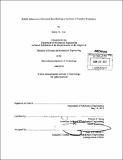Bubble behavior in subcooled flow boiling on surfaces of variable wettability
Author(s)
Tow, Emily Winona
DownloadFull printable version (10.30Mb)
Other Contributors
Massachusetts Institute of Technology. Dept. of Mechanical Engineering.
Advisor
Evelyn N. Wang.
Terms of use
Metadata
Show full item recordAbstract
Flow boiling is important in energy conversion and thermal management due to its potential for very high heat fluxes. By improving understanding of the conditions leading to bubble departure, surfaces can be designed that increase heat transfer coefficients in flow boiling. Bubbles were visualized during subcooled nucleate flow boiling of water on a surface of variable wettability. Images obtained from the videos were analyzed to find parameters influencing bubble size at departure. A model was developed relating the dimensions of the bubble at departure to its upstream and downstream contact angles based on a rigid-body force balance between momentum and surface tension and assuming a skewed truncated spherical bubble shape. Both experimental and theoretical results predict that bubble width and height decrease with increasing flow speed and that the width increases with the equilibrium contact angle. The model also predicts that the width and height increase with the amount of contact angle hysteresis and that the height increases with equilibrium contact angle, though neither of these trends were clearly demonstrated by the data. Several directions for future research are proposed, including modifications to the model to account for deviations of the bubbles from the assumed geometry and research into the parameters controlling contact angle hysteresis of bubbles in a flow. Additionally, observations support that surfaces with periodically-varying contact angle may prevent film formation and increase the heat transfer coefficients in both film and pool boiling.
Description
Thesis (S.B.)--Massachusetts Institute of Technology, Dept. of Mechanical Engineering, 2012. Cataloged from PDF version of thesis. Includes bibliographical references (p. 59).
Date issued
2012Department
Massachusetts Institute of Technology. Department of Mechanical EngineeringPublisher
Massachusetts Institute of Technology
Keywords
Mechanical Engineering.